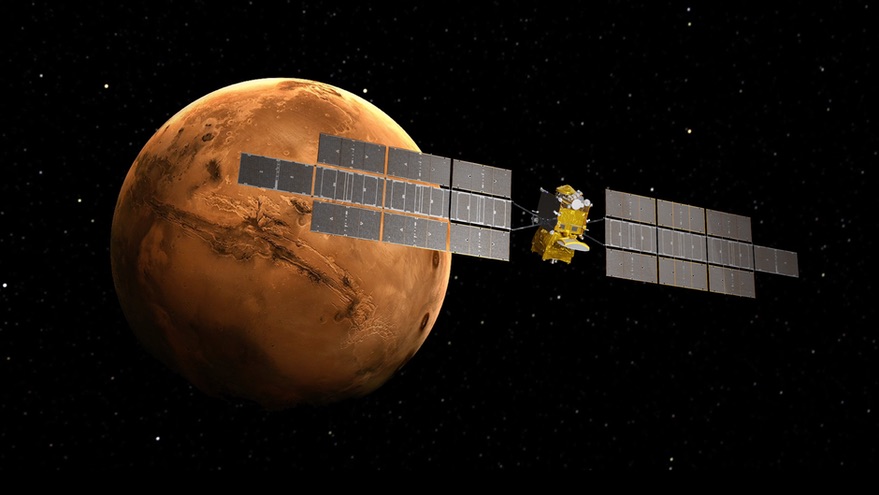WASHINGTON — NASA and the European Space Agency expect to spend at least $7 billion to collect samples of Mars and return them to Earth, a process that will start with the impending launch of NASA’s Mars 2020 mission.
Mars 2020 will deliver to the surface of Mars a rover named Perseverance, whose primary mission will be to collect up to three dozen rock samples, placing them in tubes cached on the Martian surface or on the rover itself. The mission remains on track for a launch at 7:50 a.m. Eastern July 30 on an Atlas 5 from Cape Canaveral, Florida.
Those samples will be returned by two future missions, currently projected to launch in 2026. One will be a NASA-developed lander carrying a European “fetch rover” that will pick up the sample tubes and return them to the lander. Perseverance may also deliver some sample tubes directly to the lander. Those tubes will be loaded into a container that is launched into orbit by a small rocket, called a Mars Ascent Vehicle.
The second mission will be the ESA-led Earth Return Orbiter mission, which will collect that sample container in Mars orbit using a containment system provided by NASA. The orbiter will then leave Mars orbit and head back to Earth. A capsule carrying the sample container will land in the Utah desert in 2031.
David Parker, director of human and robotic exploration at ESA, announced at a July 28 NASA press conference that the agency plans to award a contract to Airbus Defence and Space of France to build the Earth Return Orbiter. Airbus will partner with Thales Alenia Space of Italy on the spacecraft.
“Together they’re kind of the European ‘dream team,’” he said, because of their experience on a range of other ESA science missions. Terms of the contract, which is still subject to negotiation, were not disclosed.
The orbiter, Parker said, will be a large spacecraft, weighing 6.5 metric tons and with a solar panel “wingspan” of more than 35 meters. The large solar panels are required for the spacecraft’s electric propulsion system that will allow the spacecraft to raise and lower its orbit around Mars and head back to Earth.
ESA previously awarded study contracts to Airbus Defence and Space in the United Kingdom for the fetch rover that will fly on the NASA lander mission. Parker said rover will leverage the work done on the Rosalind Franklin rover built for the ExoMars mission, whose launch was delayed from 2020 to 2022 because of other technical issues as well as impacts of the coronavirus pandemic. The fetch rover will be about the half the mass of Rosalind Franklin rover but will be able to move quickly.
Parker estimated the total cost of ESA’s involvement in the overall Mars sample return campaign at 1.5 billion euros ($1.75 billion) over the next decade. ESA received the first third of that funding at its Space19+ ministerial meeting last November.
NASA is still in the early phases of developing its contributions to Mars sample return beyond Mars 2020. At the NASA briefing, Thomas Zurbuchen, NASA associate administrator for science, said the agency’s fiscal year 2021 budget proposal had a “first guess” for the cost of future Mars sample return missions at $2.5–3 billion. A firm cost estimate won’t come until a confirmation review later in the development of the lander mission.
Mars 2020 cost $2.4 billion to develop, and the agency has budgeted $300 million for the mission’s first Martian year — 687 Earth days — of operations. That would bring the overall cost of Mars sample return, when including all three missions and the contributions by both NASA and ESA, to at least $7 billion.
That estimate, Zurbuchen said, doesn’t include the cost of a sample return facility that will host the samples after they return to Earth for analysis. There will be opportunities for international collaboration in developing and using that facility, he said.
That facility will require a sophisticated design to protect the samples from being contaminated by the terrestrial environment, and vice versa. Lisa Pratt, NASA’s planetary protection officer, said the facility will have biosafety protections similar those the most advanced facilities for dealing with pathogens. “Not that we really think there will be anything pathogenic or highly dangerous from Mars, but we’re going to be extremely cautious,” she said.
Despite the expense and challenges of Mars sample return, scientists say it’s critical to bring samples back to Earth where they can be studied in laboratories far more advanced than any instrument that can be sent to Mars on a spacecraft. Doing so, they argue, is needed to conclusively identify any biosignatures, or evidence of past Martian life.
“As capable as the rover is, we’ll have really intriguing evidence” of past life, said Chris Herd, Mars sample return participating scientist at the University of Alberta, during the briefing. “But to have that definitive proof, we need to bring those samples back and see them in the lab.”
